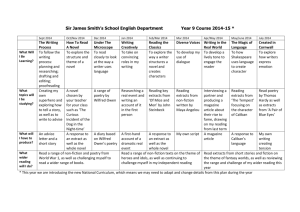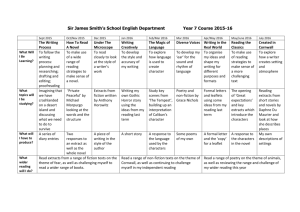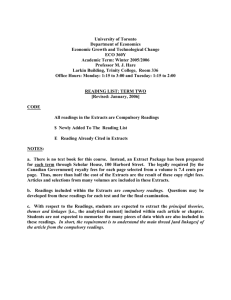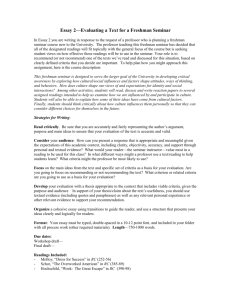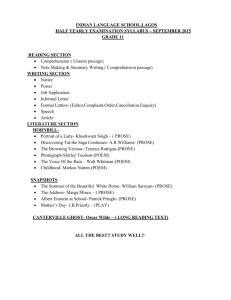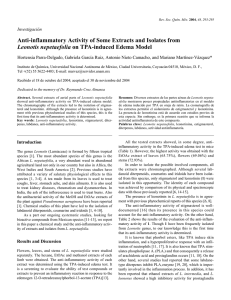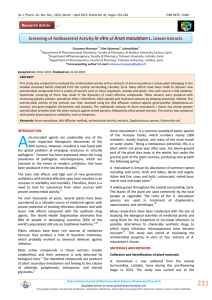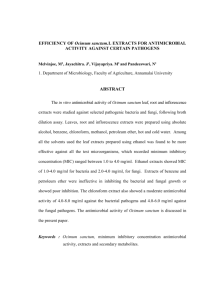University of Kent at Canterbury
advertisement
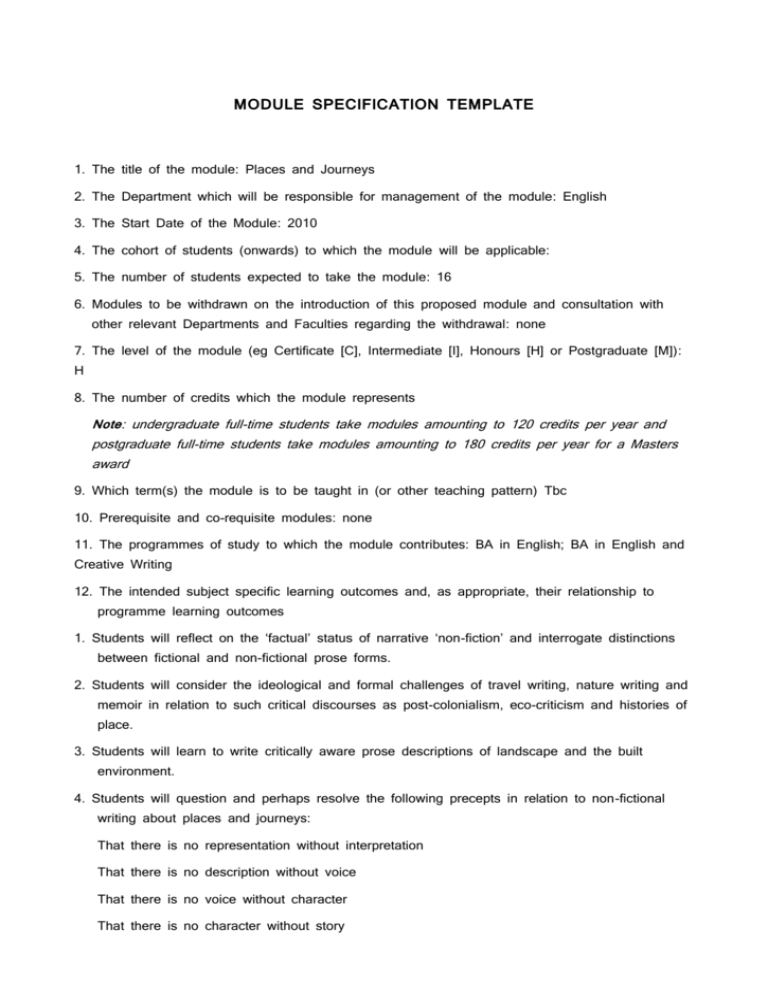
MODULE SPECIFICATION TEMPLATE 1. The title of the module: Places and Journeys 2. The Department which will be responsible for management of the module: English 3. The Start Date of the Module: 2010 4. The cohort of students (onwards) to which the module will be applicable: 5. The number of students expected to take the module: 16 6. Modules to be withdrawn on the introduction of this proposed module and consultation with other relevant Departments and Faculties regarding the withdrawal: none 7. The level of the module (eg Certificate [C], Intermediate [I], Honours [H] or Postgraduate [M]): H 8. The number of credits which the module represents Note: undergraduate full-time students take modules amounting to 120 credits per year and postgraduate full-time students take modules amounting to 180 credits per year for a Masters award 9. Which term(s) the module is to be taught in (or other teaching pattern) Tbc 10. Prerequisite and co-requisite modules: none 11. The programmes of study to which the module contributes: BA in English; BA in English and Creative Writing 12. The intended subject specific learning outcomes and, as appropriate, their relationship to programme learning outcomes 1. Students will reflect on the ‘factual’ status of narrative ‘non-fiction’ and interrogate distinctions between fictional and non-fictional prose forms. 2. Students will consider the ideological and formal challenges of travel writing, nature writing and memoir in relation to such critical discourses as post-colonialism, eco-criticism and histories of place. 3. Students will learn to write critically aware prose descriptions of landscape and the built environment. 4. Students will question and perhaps resolve the following precepts in relation to non-fictional writing about places and journeys: That there is no representation without interpretation That there is no description without voice That there is no voice without character That there is no character without story 5. Students will develop their skills as close readers and will learn to relate these skills to their practice as writers of narrative non-fiction prose. 6. Students will understand some of the connections between literary and cultural history and their own subjectivities as writers. 13. The intended generic learning outcomes and, as appropriate, their relationship to programme learning outcomes i. ii. iii. iv. v. vi. vii. application of the skills needed for academic study and enquiry ability to synthesise information from a number of sources in order to gain a coherent understanding of theory and practice; ability to synthesise material from a number of sources in a coherent creative whole the ability to frame oral criticism of creative work sensitively and constructively and to digest it to good effect develop powers of communication and the capacity to argue a point of view, orally and in written form, with clarity, organisation and cogency enhance confidence in the efficient presentation of ideas designed to stimulate critical debate competence in the planning and execution of essays and project-work and in the conception, planning, execution and editing of individual creative work enhanced skills in collaborative intellectual or creative work, including more finely tuned listening and questioning skills the ability to understand, interrogate and apply a variety of theoretical positions and weigh the importance of alternative perspectives 14. A synopsis of the curriculum This is essentially a module about describing things and about the consequences of doing so, and the expectation is that students will be able to apply insights derived from the close reading of set texts to their own practice as writers. The course is organised thematically. Weekly set readings, as well as offering examples of literary approaches to places and journeys, will encourage students to reflect on the cultural constitution and history of place and space, facilitating writing that is alert to its own conventions and constraints. The set readings are intended to strike a particular note to which students are invited to respond, rather than epitomising all there is to say about a given topic. Students will also be encouraged to visit places or simulacra of places they wish to write about, and to reflect on the difference between writing about visited and unvisited landscapes and buildings. 15. Indicative Reading List 1.Mountains: extracts from Wordsworth’s 1805 Prelude and from Robert MacFarlane’s Mountains of the Mind. 2. Sea: essays by Jonathan Raban and Orhan Pamuk 3. Islands, uninhabited: extracts from Robinson Crusoe and from Adam Nicolson’s Sea Room. 4. Rivers: Jonathan Raban, Old Glory 5. The City: extracts from Henry Mayhew, London’s Underworld;; Joan Didion ‘New York’ in Sentimental Journeys 6: Reading Week 7. Museums: Jan Morris, ‘On Looking at Things’; ‘People of the Potlatch’ and ‘Art of the British Columbia Indian’ from Solitary Raven: The Selected Writings of Bill Reid 8. Roads: Jack Kerouac, On the Road; Ian Parker, ‘Traffic’ 9. Trains: Jenny Diski, Stranger on a Train 10. Sky: Esther Woolfson, ‘Of Flight and Feathers’ from Corvus; ‘Ice and Light’ from Barry Lopez, Arctic Dreams; William Fiennes, The Snow Goose. 11. Home: extracts from the Journals of Dorothy Wordsworth, extracts from Sara Maitland’s A Book of Silence. All extracts will be provided in a course pack. The books students are asked to purchase are readily available in paperback. 16. Learning and Teaching Methods, including the nature and number of contact hours and the total study hours which will be expected of students, and how these relate to achievement of the intended learning outcomes There will be 10 2 hour seminars, during which students will work together to make close readings of the set texts and to extrapolate from these readings points for discussion in relation to their own writing (SSLOs 1 and 2; GLOs 2 and 3). Students may be invited to bring alternative passages on the same theme to the seminar and to explain how such texts contradict or interact with those set (SSLOs 1 and 2; GLOs 1 and 2). Some seminars may also include ‘still life’ exercises, where students are asked to write a brief description of an object or image provided either by the seminar leader or by another student. 17. Assessment methods and how these relate to testing achievement of the intended learning outcomes As formative assessment, and to give an opportunity to write without “credit risk”, students will submit one picture postcard each week. The relationship between the image (which could be illustrated, customised or otherwise designed by the student) and the text will form part of the assignment, and the postcard should include 100 – 300 words demonstrating literary engagement with the week’s theme, however broadly interpreted. The seminar leader will provide a brief written response to each card. At the end of term students will submit one 4,000 word piece of narrative non-fiction prose demonstrating understanding of the learning outcomes and assessment criteria. The 4,000 word creative writing piece will carry 90% of the total grade and 10% will be given for seminar performance. 18. There are no particular implications for learning resources, including staff, library, IT and space. 19. As far as can be reasonably anticipated, the curriculum, learning and teaching methods and forms of assessment do not present any non-justifiable disadvantage to students with disabilities:
